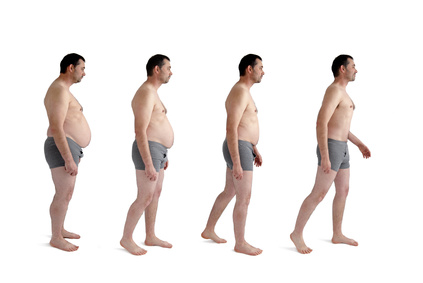

Want to lose weight? Change your genes.
Posted on August 21, 2016 by Dr. G
Want to lose weight? Change your genes.
No, we are not talking about manipulating your DNA in a laboratory. At least, I am not. I’m not very trusting that researchers will take into account all of the factors that 600 million years of evolution (and perhaps the hand of God) did. I know there are teams of researchers in labs all over the world looking for the next billion-dollar blockbuster drug or procedure that carries with it a list of warnings that would make Dr. Frankenstein cringe, to solve the obesity problem.
In this post, I want to discuss how we can take the what we’ve learned in recent years and apply it now, naturally and healthfully, to not only lose weight but to restore productivity, energy, and happiness.
Losing weight can lift depression?
Sure it can, you are getting thinner and that makes you happy, right? Not so fast. It turns out that the mechanism of why weight loss can lift depression has little to do with being happy you “look better”. Now let’s not underestimate the value of an improved body image, better fitting clothes, etc. It’s a positive experience that has social value, but I am talking about depression that is physiological not circumstantial.
Physiological depression is a neurochemical, neuroendocrine, and immunological process. I’ve written on this topic in the past. Where I’ve discuss the inflammatory model of depression and anxiety, where the immune system is driving the process. I want to expand on that article in this post and center the attention on body fat.
Obesity is growing in line with many other chronic diseases, and there is no doubt that obesity is both a cause of and is caused by most modern chronic diseases.
1 billion people on planet Earth are clinically overweight and 300 million (nearly the population of the entire U.S.) are obese. The 20th century model of obesity (a false model) is one that says increases of body fat represent a storage of energy (food) consumed when that energy consumed exceeds the energy we burn. This model is a simple math equation, consume less food (less energy) and exercise more (burn more energy), and you will move in the right direction. While this is true and works for people in the short term, it is a poor solution in the long term since 98% of people who lose weight gain it all back and then some in less than 2 years. Just take a look at all of the contestants of the hit reality television show “The Biggest Loser”.
The weight loss model described above is one that places the blame of obesity square on the individual suffering from the disease (yes, it is a disease) due to their apparent lack of “will power” and some form of weakness, deficiency of character, or lack of self control. This model leaves our medical professionals searching for solutions that are short cuts like drugs with dangerous side effects, or surgeries that give temporary cosmetic results and may cause nutritional deficiencies and digestive disorders (gastric bypass). There are cosmetic surgeries like liposuction that give an initial experience of quickly achieving goals but ultimately wind up causing cosmetic problems associated with depositing fat where you never had it before (neck, arms, lower legs, face, etc.).
This is a very big topic of discussion, and I am not going to touch on all of the issues involved such as lack of exercise, sedentary jobs, poor food choices, and the production of foods that frankly should not have the distinction of being called food.
Energy production:
In this post, I want to address the topic of “ENERGY”. After all, energy production is the purpose of the 3 main categories of food (Fat, Protein, Carbohydrate) and energy production is how our bodies express health, happiness, and work. From my recent posts, you will see that I have been writing quite a bit on the role of the energy factory of our cells called the mitochondria. The mitochondria and their function are implicated in virtually every chronic illness including heart disease, diabetes, cancer, Alzheimer’s, Parkinson’s, all forms of dementia, MS, autoimmune disease, and obesity.
Our mitochondria begin to fail when they are damaged; this results in the inability to produce (burn) energy efficiently. Less energy produced equals more energy stored. This is a classic model. The sicker we get the bigger we get, regardless of calories consumed compared to calories burned.
Damage to the mitochondria is caused by oxidation triggered by inflammation. Remember, inflammation is activation of the immune system. When chronic, it effects our brain chemistry in profound ways resulting in sleeping disorders, brain fog, fatigue, depression, anxiety, and obesity to name a few.
Mitochondria and Fat
We have 2 types of fat in our body: white adipose tissue (WAT) and brown adipose tissue (BAT). Brown adipose tissue is fat that has an abundance of functioning mitochondria, giving it its brown color. White adipose tissue is fatty tissue that accumulates around the midsection and around our abdominal organs which has a lack of mitochondria. It was always thought that the WAT functioned merely as storage for excess triglycerides (fat), and when extra energy is needed, the WAT would release the fatty acids into the blood stream for use as energy and over time resulting in weight loss. We now know that the WAT cells actively produce inflammatory cytokines that contribute to the chronic state of inflammation seen in the chronic diseases mentioned above. The inflammatory cytokines are toxic to the mitochondria.
The brown adipose tissue (BAT) has a function that is different. The presence of mitochondria in the BAT seems to be for the purpose of generating heat. The BAT accomplishes this by releasing a protein called thermogenin. Thermogenin produces heat by a mechanism I will mention below.
Mitochondria are batteries:
Let’s see if we can tie this all together and skip a million other factors and still make sense, otherwise wed have to write a text book and your eyes would glaze over. In recent years we have discovered that if we have 2 people who consume the same number of calories and have the same activities of daily living, one can be thin the other can be obese. This has been explained by the efficiency by which the mitochondria produce energy. The mitochondria are little battery packs (energy potential). The more efficient your mitochondria are, the greater their energy storage, the stronger the battery. The less efficient the mitochondria, the more energy lost to heat, the weaker the battery.
Tightly coupled or loosely coupled
In our example, the thin person is the less efficient and produces more heat. This happens when the mitochondria leaks protons, this is called loosely coupled. The obese person is more efficient, produces less heat, and the mitochondria does not leak protons- this is called tightly coupled. A more tightly coupled mitochondria, seems better, it sounds like you’d want to be more efficient, and perhaps that is true in a calorie deficient environment. In the U.S., we live in a calorie abundant environment. Never has there been more easy access to cheap empty calories.
It was thought that being loosely coupled or tightly coupled determined by the luck of our genetic lot. We now know that thermogenin released by brown adipose tissue can modulate how tightly or loosely coupled we are, it changes.
Brown adipose tissue also releases more anti-inflammatory cytokines (chemicals that turn off the chronic immune response resulting in better brain and hormone chemistry). That’s right, less depression. Of course, there are many moving parts to this story, and we are not saying that obesity or excessive white adipose tissue is the cause of depression for everyone. We are saying however that, obesity is one cause of excessive inflammation, and immune activity in the body resulting in suffering on many levels.
We have begun to discover how to increase BAT and decrease WAT. Our patients are finding that the way forward includes making changes in food and physical activities, but it also may require us to make changes to our environment as it relates to temperature, exposure to daylight, exposure to artificial light, as well as the use of botanicals, nutra-ceuticals, and dietary supplements. It also means improving how our nervous systems coordinate all of these factors. It takes a comprehensive lifestyle-based approach to make long term change.
Thanks for reading!





